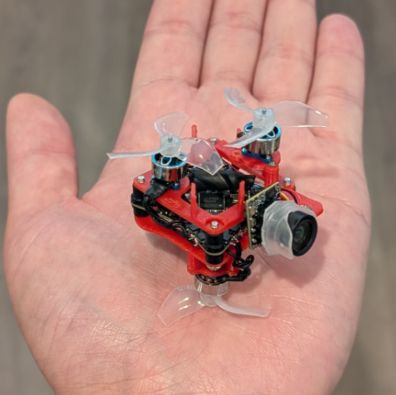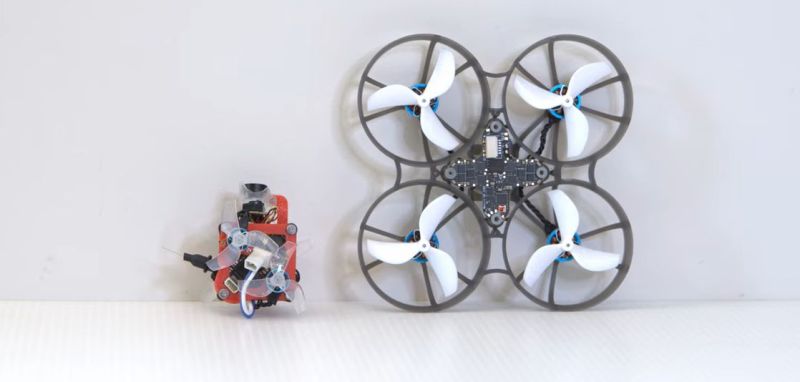First person view (FPV) quadcopter drones have become increasingly more capable over the years, as well as much smaller. The popular 65 mm format, as measured from hub to hub, is often considered to be about the smallest you can make an FPV drone without making serious compromises. Which is exactly why [Hoarder Sam] decided to make a smaller version that can fit inside a Pringles can, based on the electronics used in the popular Air65 quadcopter from BetaFPV.

The basic concept for this design is actually based on an older compact FPV drone design called the ‘bone drone’, so called for having two overlapping propellers on each end of the frame, thus creating a bone-like shape. The total hub-to-hub size of the converted Air65 drone ends up at a cool 22 mm, merely requiring a lot of fiddly assembly before the first test flights can commence. Which raises the question of just how cursed this design is when you actually try to fly with it.
Obviously the standard BetaFPV firmware wasn’t going to fly, so the next step was to modify many parameters using the Betaflight Configurator software, which unsurprisingly took a few tries. After this, the fully loaded drone with camera and battery pack, coming in at a whopping 25 grams, turns out to actually be very capable. Surprisingly, it flies not unlike an Air65 and has a similar flight time, losing only about 30 seconds of the typical three minutes.
With propellers sticking out at the top and bottom – with no propeller guards – it’s obviously a bit of a pain to launch and land. But considering what the donor Air65 went through to get to this stage, it’s honestly quite impressive that this extreme modification mostly seems to have altered its dimensions.
Thanks to [Hari] for the tip.
















Worlds smallest public one. Rumored secret places have horsefly sized ones, but suspect it’s classified
Imagine a pinworm-sized robot controlled by MEMS actuators and STM32F4 microcontroller. It crawls up your anal cavity during sleep. Once it penetrates your body, it’s microelectronics modify your DNA to produce TNT instead of fat. Once enough is produced, this robot acts like a detonator, turning you into a walking bomb.
This is the future of state-sponsored terrorism. I wouldn’t be surprised if MIT’s black-ops faculty is already working on a prototype.
I’d rather not!
No, Not the Bore Worms!
You had me at ‘anal cavity’. One snag in your plan, the whole DNA modification bit.
This entire design was stolen and wasn’t this guys design. Im the original designer, he copied everything down to using the same flight controller, motors, camera, battery prop orientation and frame design. Nothing about this design was an original idea. I also broke “his” 22.3mm record 18hrs after he posted that video. I commented on the video stating all of this with already posted videos time stamped before his video.
https://www.reddit.com/r/fpv/s/ur5KMzLt2g
As someone that also did a thing then had it blatantly ripped off and un-attributed, I’m sorry to hear that and it sucks.
Or they just made something similar to you. Accusing someone of “stealing” your design because they might have seen your short reddit video is kind of insane. Reverse engineering what parts you used, ordering the parts, CAD modeling, assembling and tweaking the flight control all while recording and editing a 30 minute YouTube in 3 days would be more impressive than the actual build itself.
Fantastic Voyage from the drone’s POV. Nose hairs like trees.
22 mm? Less than an inch? Where did he get the tiny hand model? A ruler in the photo would have gone a long way, but I understand rulers are expensive and rare.
less then 2 inch
25.4mm/inch. Less than one inch.
Using a hand is an easy way to around the metric vs imperial discussion. There is a very good reason why bananas are getting more popular for measurements. As we speak, rumors are already going around that NASA is working on converting their measurements into banana units. Keep in mind that these are fresh and calibrated bananas of a special brand (which type is uncertain at this point) as these are the most accurate. The benefit of a banana vs a standard ruler is that it allows to specify curves, something an ordinary ruler is incapable of, speaking of incapable rulers… but that’s another topic.
The quadcopter revolution really is something to witness. In the featherweight model airplane world, they’re going to absurd steps to minimize weight and maximize aerodynamic surface area…but this thing is just the ugliest little chunk you ever saw and i guess it still flies! Just amazing how power density has totally changed the problem space.
A quad just needs power-to-weight, and basically the limiting factors are the motor and the battery. Everything else can be made smaller and lighter.
The Air75, the bigger brother of the quad that he rips apart for this one, flies fantastic and weighs 21 g (3/4 oz) without the battery. But with everything else that you need to fly. Camera, motor drivers, radio control, frame. And it’s mass production. 21 grams…
Hackers can get down to ~19 g in that size class, but that involves PEET screws and some serious compromises.